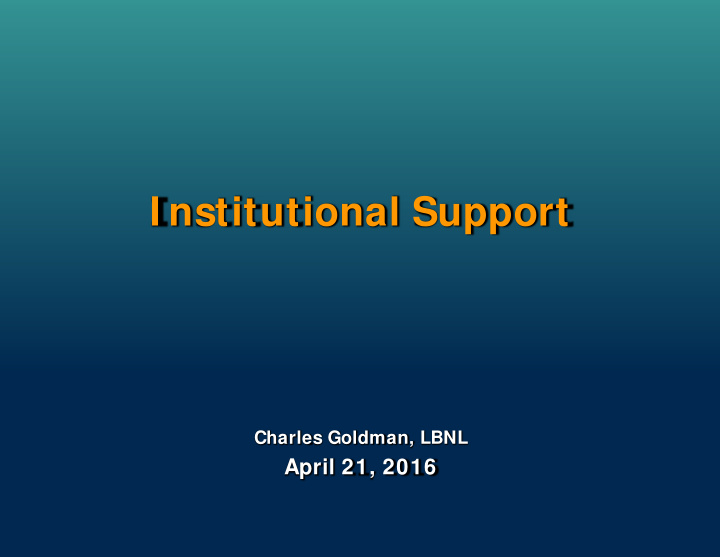



I nstitutional Support Charles Goldman, LBNL April 21, 2016
I nstitutional Support Multi-year Program Plan for Institutional Support focus area has four main activities. • Provide Technical Assistance to States and Tribal Governments • Support Regional Planning and Reliability Organizations • Develop Methods and Resources for Assessing Grid Modernization: Emerging Technologies, Valuation, and Markets • Conduct Research on Future Electric Utility Regulations Each activity has specific goals and target achievements to be completed by 2020.
DER in Regional Electric System Planning High DSM Scenario Energy Efficiency Savings AB AZ BC CA CO ID MT MX NV NM OR UT WA WY WECC Ongoing TA to WECC/WGA; modeling of energy 0% Percentage Energy Savings Relative -5% efficiency, demand response, and distributed Reference Case -10% generation -15% -20% Analyzed (and adjusted) balancing authority load -25% -30% forecasts to ensure that WECC reference case Updated DR Potential accounts for current state DER policies (Percent of Peak Demand) Developed high EE load forecasts based on EE potential studies Updated DR potential estimates and developed DR dispatch algorithms for WECC production cost models Supported development of DG-PV scenario tool for WECC transmission planning
Energy Zones Mapping Tool (EZMT) EZMT was originally developed for Eastern Interconnection (EISPC); now being extended to entire United States Broad energy resource scope (9 energy resources) Hom e Page ( http:/ / ezm t.anl.gov) Mapping library (270+ layers) focused on energy resources & infrastructure, siting factors Flexible energy technology suitability models (38 different technologies/70 siting factors) Flexible energy corridor analysis/route modeling tools Dynamic, geographically specific reports (20 topics) Searchable policy database (~ 2,400 policies, Energy Zones Mapping Tool, w ith w ind regulations, and incentives) speed, transm ission lines, and pow er plants
Southwest Utility Future Fuel and Purchased Power O&M Depreciation Electric Utility Interest on Debt Reduction in Revenue Requirement Return on Rate Base Taxes ($B, 20-yr NPV @ WACC) 2.5 5% Percent of Total Costs (right axis) Regulation 2.0 4% Reduction as Percent of Total Costs 1.5 3% 1.0 2% UTILITY BUSINESS MODELS & REGULATION 0.5 1% Developed FINDER model to quantify and assess 0.0 0% 2.5% 5% 7.5% 10% financial implications of EE, DR, and DER on utility Customer Demand Met With PV by 2022 shareholders and ratepayers 0% TA assistance to state PUCs and utilities (e.g., AZ, Met With PV by 2022 Customer Demand 2.5% -0% KS, MA, IL, and NV, two regional workshops) Case studies: Financial impacts of net-metered PV 5% -1% on prototypical investor-owned utility in southwest 7.5% -2% and northeast DISCO 10% -3% Results: impacts could be mitigated through 7.0% 7.5% 8.0% 8.5% 9.0% various ratemaking and policy approaches Achieved After-Tax ROE (Avg.; 10-yr)
Future Electric Utility Regulation: Work Products 1 . Distributed Energy Resources (DERs), Industry Structure and Regulatory Responses. Steve Corneli & Steve Kihm 2. Distribution Systems in a High DER Future: Planning, Market Design, Operation and Oversight. Paul De Martini & Lorenzo Kristov (CAISO) 3. Performance-Based Regulation in a High DER Future. Tim Woolf & Mark Lowry 4. Distribution System Pricing for DERs. Ryan Hledik & Jim Lazar (RAP) 5. Future of Resource Planning. E3 and LBNL 6. Recovery of Utility Fixed Costs: Utility, Consumer, Environmental and Economist Perspectives. LBNL, Lisa Wood, John Howat (NCLC), Ralph Cavanagh, Severin Borenstein (UC)
GMLC: I nstitutional Support Projects • Foundational Analysis: Metrics • Grid Services & Technologies Valuation Framework • Distribution System Planning: Decision Support Tools • Future Electric Utility Regulation Regional Projects • New York: Technical Support to the Reforming Energy Vision (REV) Initiative • California: DER Siting and Optimization Tool to enable large scale deployment of DER
California: DER Siting and Optimization Tool to enable large scale deployment of DER Goal: Deliver an online open-access integrated distributed resource planning and optimization platform, able to: • Identify DER penetration patterns based on optimized investment assessments of behind-the-meter DER • Consider optimal DER operational strategies in the process of identifying penetration patterns (e.g. PV , solar thermal, batteries, chp) • Identify sites with high economic potential for microgrid and DER deployment • Consider potential policy incentives and the value of DER as grid assets (e.g. ancillary services) • Consider network constraints in the DER location problem • Evaluate impacts of DER penetration on the bulk electric grid system and mitigate them • Major breakthrough: Tool that offers T&D co-simulation with behind-the-meter DER optimization • Direct support to CPUC to complement Distribution Resources Plans (DRP) and support the Integration of Demand-Side Resources (IDSR) • Direct support to NY REV in collaboration with NYSERDA
Recommend
More recommend